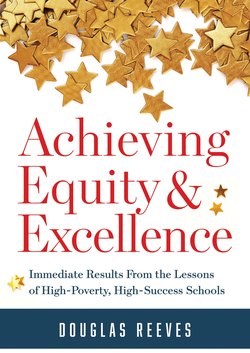Читать книгу Achieving Equity and Excellence - Douglas Reeves - Страница 9
Оглавление| PART I |
Discovering When to Trust Educational Research
Our journey begins as every educational decision must—with evidence. Since publication of the original research on equity and excellence schools (Reeves, 2004), there have been two competing narratives about the influence of poverty on student achievement. The first and dominant narrative is that demography is destiny. This is an echo of American sociologist, theorist, and empirical researcher James S. Coleman’s (Coleman et al., 1966) report, Equality of Educational Opportunity, which contends that the strongest predictor of student academic success is the mother’s level of education. From the 1960s through the early years of the 21st century, the assertion that schools with high percentages of low-income students who are members of ethnic minorities and do not speak English at home would inevitably have low achievement seemed incontrovertible. Whenever there were outliers—that is, schools with students from low-income families who performed well academically—these schools stood out because they were so unusual. This narrative remains dominant in North American education. When I present data to the contrary—that not only individual schools but also entire districts are defying the odds—some educators and administrators may challenge the accuracy and credibility of the data. Even when I present data from their own districts and schools, there remains hard-core disbelief in the notion that poor children and children of color can succeed in the American educational system.
In my keynotes, seminars, and personal conversations across the United States and around the world, I often ask, “Why do teachers and administrators distrust educational research?” The answers include the following.
• The research doesn’t apply to us. We are different because we are urban (or rural or suburban), our union contract is different, our budget is different, and our parents are different.
• The research has a tiny sample size that cannot be generalized to the broader student population.
• The research is from schools with heroic teachers and administrators, but they will burn out because their efforts are unsustainable.
• The research is commercially tainted because publishers conduct it while attempting to sell their textbooks, online systems, or instructional programs.
• The criteria for success are too low, so what the research calls meeting standards is not equivalent to what our district regards as a successful outcome.
• The per-pupil funding in the research is higher than in our schools.
• The successful schools cherry-pick students.
The objections are consistent and pervasive, so many school leaders and teachers subsequently avoid implementing the positive practices of these exemplary schools. Therefore, part I makes the important case for when readers should trust the research. Chapter 1 presents a typology of evidence, proceeding from level 1 research (personal beliefs) through level 5 research (preponderance of the evidence—the gold standard of educational research to which these chapters aspire). Chapter 2 then considers seven common challenges to educational research and offers a respectful reply to each challenge.
